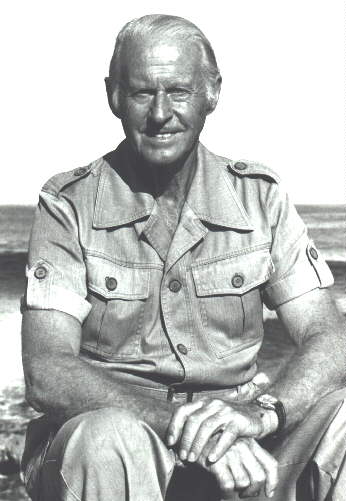
and
ARCHAEOLOGY OF THE PACIFIC PEOPLES

THOR HEYERDAHL
Early Life
Thor Heyerdahl is a world-renowned explorer and archaeologist. He was born in 1914, in Larvik, Norway. From his earliest days, he was an enthusiatic nature lover, and he was inspired by his mother (who was head of the local museum) to take an interest in zoology and nature. While still in primary school, he ran a one-room zoological museum from his home. Mr. Heyerdahl later enrolled at the University of Oslo, where he specialized in zoology and geography until leaving on his first expedition to Polynesia in 1937-1938.
The First Expeditions to Polynesia (1937-38) and Northwest America (1940-41)
Arriving in Polynesia, the young student Heyerdahl and his bride Liv were adopted by the supreme Polynesian Chief of Tahiti, Teriieroo in 1937. After training in the Polynesian way of life and customs, the Heyerdahls settled for one year on the isolated island of Fatuhiva in the Marquesas Group. While doing research on the transoceanic origins of the island's animal life, the naturalist lived an otherwise traditional Polynesian life. During this time, he began to contemplate the existing theories of how the South Pacific inhabitants reached the islands. Stuggling with the eternal easterly winds and currents whenever he and his Polynesian friends ventured into the sea to fish, he lost faith in textbook claims that these islands had been discovered and settled by as yet unidentified stone-age voyagers from Southeast Asia who had sailed and paddled against the currents for ten thousand miles. Instead Heyerdahl became convinced that human settlers had come with the ocean currents from the west just as the flora and fauna had done.
Abandoning his study of zoology, Heyerdahl began an intensive study of testing his theory on the origins of the Polynesian race and culture. He suggested that migration to Polynesia had followed the natural North Pacific conveyor, therefore turning his search for origins to the coasts of British Columbia and Peru. While working at the Museum of British Columbia, Heyerdahl first published his theory (International Science, New York, 1941) that Polynesia had been reached by two successive waves of immigrants. His theory suggested that the first wave had reached Polynesia via Peru and Easter Island on balsa rafts. Centuries later, a second ethnic group reached Hawaii in large double-canoes from British Columbia. The results of Heyerdahl's research were later published in his 800-page volume, American Indians in the Pacific (Stockholm, London, Chicago, 1952).
Interupted by the outbreak of the Second World War, Heyerdahl returned to Norway to volunteer for the Free Norwegian Forces, eventually serving in a Nowegian parachute unit in Finnmark.
The Kon-Tiki Expedition (1947)
After the war, Heyerdahl continued his research, only to meet a wall of resistance to his theories amongst comtemporary scholars. To add weight to his arguments, Heyerdahl decided to build a replica of the aboriginal balsa raft (named the "Kon-Tiki") to test his theories. In 1947, Heyerdahl and five companions left Callio, Peru and crossed 8000 km (4300 miles) in 101 days to reach Polynesia (Raroia atoll, Tuamotu Archipelago). Despite skepticisim, the seaworthiness of the aboriginal raft was thus proven and showed that the ancient Peruvians could have reached Polynesia in this manner.
The Galapagos Expedition (1952)
Following the success of the Kon-Tiki Expedition, Heyerdahl organized and led the Norwegian Archaeological Expedition to the Galapagos Islands. The group investigated the pre-Columbian habitation sites, locating an Inca flute and shards from more than 130 pieces of ceramics which were later identified as pre-Incan. The Galapagos Islands are located about 1000 km off the coast of Ecuador and thus South American archaeology was extended for the first time in to the open Pacific Ocean. Parallel to this expedition, Heyerdahl worked with experts in rediscovering the lost art of the guara, a kind of aboriginal center-board used by the indians of Peru and Ecuador for navigation. From this tool, not used on the Kon-Tiki voyage, it become clear that ancient South American voyagers had the means to navigate as well as travel great distances in the Pacific.
The Easter Island Expedition (1955-56)
Following his successful work, Heyerdahl was encouraged to direct a major archaeological expedition to the Pacific's most isolated island: Easter Island. An expedition of 23 persons reached the island and began the first sub-surface archaeological excavation every attempted. They soon discovered that Easter Island had once been wooded until deforested by its original inhabitants, who also planted water-reeds and other South American plants.
Carbon dating showed that the Island had been occupied from about 380 A.D., about one thousand years earlier than scientists previously believed. Excavations indicated that some ancient stone carvings on the Island were similar to ancient traditions in Peru. Some Easter Islanders claimed that according to their legends, they orginally arrived from the far away lands to the East. The results of Heyerdahl's work were widely discussed and presented at the Tenth Pacific Science Congress in Honolulu (1961) where they were supported by the unanimous statement: "Southeast Asia and the islands adjacent constitute one major source area of the peoples and cultures of the Pacific Islands and South America". Thus, Heyerdahl's eastern migration theory had gained considerable influence.
The RA Expeditions (1969-70)
Thor Heyerdahl continued his research on ancienct navigation and turned his attention to the ancient reed-boats made of papyrus. These boats were deemed insufficient to cross the Atlantic as the reeds were believed to become water-logged after less than two weeks on open water. Heyerdahl believed that contemporary science underestimated the the ancient vessels and undertook to prove this by experiment. In 1969, he bought 12 tons of papyrus and worked with experts to construct an ancient-style vessel. The result was a 15 m boat which was launched at the old Phoenician port of Safi, Morocco. In the spirit of cooperation, Heyerdahl embarked under the UN flag with a crew of seven men from seven countries. The papyrus craft, Ra, sailed 5000 km (2700 nautical miles) in 56 days until storms and deficiencies in the construction caused the team to abandon their target only one week short of Barbados.
Ten months later, Heyerdahl tried the same voyage with the smaller (12 meter) Ra II. This vessel crossed the widest part of the Atlantic 6100 km (3270 nautical miles) in 57 days, from Safi to Barbados. Once again, this voyage showed that modern science under-estimated long-forgotten aboriginal technologies. The theory that Mediterranean vessels built prior to Columbus could not have crossed the Atlantic was thrown on its head.
In subsequent years, Heyerdahl continued on many other expeditions, including the Tigris river (1977) and the Maldives Islands (1982, 83 and 84). Now in his eighties, Heyerdahl remains an active participant in archaeological expeditions, as well as an international promoter of cooperation and understanding between peoples across the globe.
Awards and Honors
Thor Heyerdahl is the recipient of numerous medals, awards and honours. He has been a regular member of various scientific congresses, notably the International Congress of Americanists, the Pacific Science Congress, and the International Congress of Anthropology and Ethnology.
Thor Heyerdahl Links
Kon Tiki Web Server 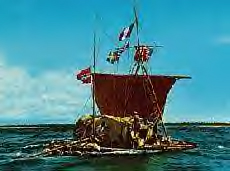
Thor Heyerdahl Expeditions
The First Kon Tiki
The Kin Tiki Museum - Norway
The Settlement of Polynesian (conventional
theory)
Easter Island Home Page
Cult Archeology Trans-Oceanic Crossings
Destination Maldives
The Pyramids of Guimar, Canary Islands
The Pyramids of Guimar, Canary Islands
Guimar
Pyramid Photo
The Origins of the Canary Islands
Excavations At Piramides De Guimar, Tenerife, Canary
Islands
Tenerife Guide to Towns
Casa Chacona Museum

At 3,800 meters above seal level, Lake Titikaka is the highest lake in the world where navigation is possible. The lake's 8,800 km2 of surface area is shared by Bolivia and Peru. In the Bolivian side, you will find the famous Suriqui, Sun, and Moon Islands.
Suriqui Island is home to the builders of Ra I and Ra II, the totora rafts that crossed the Atlantic Ocean in the 1970s under the command of Thor Heyerdahl.
The Sacred of Lake Titikaka
The Trainride to the Sky
Map of Bolivia
Destination Bolivia
MACHU PICHU
 |
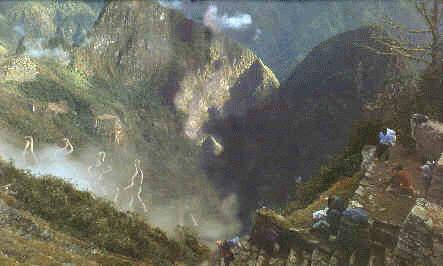 |
The Inca Trail to Machu Pichu
The Inca Trail
The Tomb of the Lord of Sipan
Magic of Bolivia Atlantis 12,000 ft. Up?
First Hand Story - Travel to Machu Pichu
Peru - 1994 - International Journeys - Personal Story
Images of Peru
Machu Pichu and the Peruvian Ice Cap
INTRODUCTION TO EASTER ISLAND
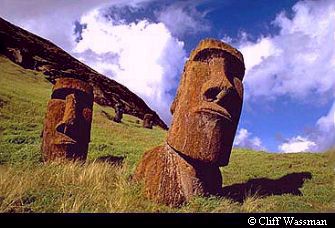
Mysterious Places - Easter Island
NOVA Online - Secrets of Easter Island
Tahiti Explorer
Pacific Studies Virtual Library
Definition of "Rapa Nui"
ORIGINS
Thor Heyerdahl Home Page
Links to Lunacy - "Alternative" theories about
Easter Island.
Polynesian Voyaging Society
RECENT HISTORY
Early Contacts with Western "Civilization"
Slavery and Disease on Easter Island
Annexation by Chile
"Trouble in the South Pacific" - LA Times 8/2/94
Rapa Nui Syndrome - Personal memoirs of Rapa Nui
Pacific Islands Yearbook - Rapa Nui
Chip News - Chile Information Project
News Updates from Rapa Nui CULTURAL
Rapa Nui Music - Original
Recording by Jörg Hertel. For more info, Contact:
Noiseworks Rec. P.O. Box 310, D - 09028, Chemnitz Deutschland
Rapanui Language Links
Rongorongo - Easter Island Hieroglyphic Script
Petroglyphs - Rock Art
Kevin Costner's film "Rapa Nui". - LA Times
reviews
Wood carvings
Tapa crafts - Figure from Peabody Museum
Tattoo Designs
Oceanic Tribal Arts
Rapa Nui Outrigger Club
Easter Island Rapa Nui
ECOLOGICAL
'Drawdown,' 'Overshoot,' 'Crash,' and 'Die-off.' - Intro to Human
Ecology
Cannibalism
Earth First! - The Lessons of Easter Island
Easter Island - 1998 - ecology
The Changing Ecology over 700 years
SCIENTIFIC INQUIRY
South Seas Symposium (August 6-9, 1997)
Polynesian Archaeology
Ancient Seaports
TRAVEL LINKS
Lan Chile Airlines
Adventure Travel Worldwide - Easter Island Expedition
Far Horizons Archaeological and Cultural Tours
South America at MILA
Hotels on Easter Island
Residenciale Mahina Taka-Taka Georgia
Photos of Mataveri Airport
RESOURCES
Easter Island Foundation
Moon Publications' "South Pacific Handbook"
Lonely Planet's Chile and Easter Island - Travel Survival
Kit -
Pacific Island Internet Resources
MAPS AND PHOTOGRAPHS
Topographical Map of Easter Island
Easter Island Virtual Tour - Cliff Wassman
Art of Lorenzo Domínguez - Sculptor and Painter (1901-1963)
A Japanese Easter Island site
Påskön (Swedish site)
Île de Pâques (French site)
Images Aquarone
Easter Island Woman
AfricaMuse on Easter Island
MISCELANEOUS LINKS
Local Time on
Easter Island
Easter Island Weather Report - CNN
"Easter Island at home" - Archie
McPhee Catalogue
Rapanui Fonts
Rapa Nui Puzzle
Rapa Nui: Clouds of Mystery
Over the Edge
NEWSGROUPS
rec.travel.latin-america
sci.archaeology
soc.culture.chile
soc.culture.pacific-island Iorana
MALI
THE MAYANS
Chichen Itza
Monastery of Izamal, Yucatan, Mexico
Pyramid of Kulkulkan/Quetzalcoatl Chichen Itza, Yucatan,
Mexico
Pyramid of the Magician Uxmal, Mexico
Mound J Astronomical Observatory Monte Alban, Mexico
Mt. Iztacihuatal from Mt. Popocatepetl Mexico
History of Oceania
Where is Samoa? It is in the South Pacific and midway between Hawaii and New Zealand and it consists of two entities; Western Samoa - an independent nation since 1961 - and American Samoa - a U.S. Territory since 1900. This site offers you a map showing the logistics of Samoa in relation to Asia, the United State and New Zealand, along with a look at Samoa's history, geography, government, and population with some really fantastic photos.
This is a very thorough site on the Cook Islands covering Geography, History, The People, Culture and Art, the capital island of Rarotonga, and much more.
FIJI
The Fiji Islands
Site has information on the geography, people, economy, society, culture and history
of Fiji.
Fiji Travel Guide
This travel guide has lots of information on the culture, geography, history,
people, and land of Fiji. Good pictures.
This site gives an excellent account of Guam's history, from a native son of Guam, a retired general officer of the Marines, and a former Member of the U.S. Congress (1985-93), Ben Blaz. Great pictures.
Republic of the Marshall Islands Internet Guide
General Information of the Marshall Islands
Micronesia, Federated States of
Destination Micronesia
A travel agent has set up this site and it has lots of information and beautiful pictures on the islands of Palau, Guam, Marianas,
Pohnpei, Yap, Chuuk, Marshalls,
and Kosrae.
Federated States of Micronesia More beautiful pictures at this site and information
on the islands of Chuuk, Kosrae, Pohnpei and Yap.
Midway Island was discovered in 1859, was kept secret for several years but eventually word leaked out. In 1876 the U.S. Government sent Captain William Reynolds to the island where he took formal possession. President Theodore Roosevelt issued an executive order in 1903 which placed Midway under the jurisdiction and control of the United States Navy and in 1908 it was annexed to become the first island belonging to the United States beyond its continental shores. The site explains the events that happened during and after the Pearl Harbor attack, closing of the island, geography, stories and memories of Midway, and a nice selection of photos.
Nan Madol is a lost city made of stone "logs" that are 18 feet long and several feet in diameter.
Each stone is estimated to weight up to two and a half tons - so why was Nan Madol built? We really don't know.
Abandoned hundreds of years ago, it remains an archeological mystery. Visit the site and see some great pictures.
A Tour of Pohnpei
A student missionary teaching at a Seventh Day Adventist School in Pohnpei set up this site with a nice description
of Pohnpei and the school where he taught along with some beautiful pictures.
LEMURIA
Spiritweb: Mu, Atlantis, Lemuria
Lemuria.net
History of Neo-Lemuria
SPECIAL MENTION
The Sword of Heaven - On Line Book
A Travel Diary of Five Continents
Bibliography
Paa jakt efter Paradiset. Oslo (1938)
The Kon-Tiki Expedition. (translated into 64 languages), Oslo (1948)
American Indians in the Pacific, The Theory Behind the Kon-Tiki Expedition. Stockholm, London, Chicago (1952)
Archeological Evidence of Pre-Spanish Visits to the Galpagos Islands. (With A. Skjoldsvold). Memoir of the Soc. for American Archeology, N. 12. Salt Lake City (1956)
AKU-AKU. The Secret of Easter Island. (translated into numerous languages). Oslo (1957)
Reports of the Norwegian Archeological Expedition to Easter Island and the East Pacific. (With co-editor: E.N. Ferdon, Jr.). Vol. I: Archeology of Easter Island. Vol. II: Miscellaneous Papers. Monograph of American School of Research, the Musem of New Mexico and the Kon-Tiki Museum. Santa Fe, London, Chicago, Oslo (1961)
Vanished Civilizations. (co-author chapter: Navel of the World). London (Thames Hudson) (1963)
Sea Routes to Polynesia. London, Chicago (1967), (various translations from the original: Indianer und Alt-Asiaten im Pazifik. Vienna 1965)
The Ra Expeditions. (numerous translations), Oslo (1967)
Quest for America. (co-author, chapters: Isolationist and Diffusionist and The Bearded Gods Speak). Pall Mall Press Lts., London (1971)
Note: (Heyerdahl's English language publishers are Allen Unwin Ltd., London, Rand Mc Nally Company, Chicago, and Doubleday Co. Inc., New York).
THE DEATH OF THOR HEYERDAHL
Heyerdahl: 'Kon-Tiki man' to the end
'I say no European has discovered anything but Europe'
April 18, 2002 Posted: 4:59 PM EDT (2059 GMT)
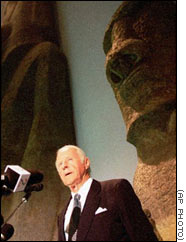
Thor Heyerdahl was honored five years before his death to the day -- April 18, 1997 -- at the Kon-Tiki Museum in
Oslo, Norway, where he was pictured near a stone statue from Easter Island.
GUIMAR, Canary Islands (AP) -- It has been a half-century since Thor Heyerdahl and five other Scandinavians made
history by sailing the Kon-Tiki raft across the Pacific, nearly drowning at the end of the 101-day voyage when
they smashed into a coral reef of an uninhabited Polynesian atoll.
The first ham radio operator to pick up their distress call didn't believe them, so they sent another: "All
well. All well. All well."
To which another ham answered, "If all's well, why worry?"
As Heyerdahl -- who died Thursday (read the obituary) -- would later describe it, it was a somewhat comical finale
to a 5,000-mile odyssey in pursuit of an answer to one of Earth's abiding mysteries: How did humankind spread from
one continent to the next?
"The Kon-Tiki expedition opened my eyes to what the ocean really is. It is a conveyor and not an isolator.
The ocean has been man's highway from the days he built the first buoyant ships, long before he tamed the horse,
invented wheels and cut roads through the virgin jungles," he wrote in the foreword to the 35th edition of
"Kon-Tiki, Across the Pacific by Raft," the best seller that catapulted him and the balsa log raft to
international fame.
Kon-Tiki: The moon landing of its time
A half-century after Thor Heyerdahl sailed almost 5,000 miles on the Kon-Tiki his theories of intercontinental
human migration are still being debated -- frequently by admiring colleagues.
Heyerdahl, a Norwegian who moved to the Spanish island of Tenerife off the west coast of Africa in 1990, has spent
his life gathering evidence -- from astronomically oriented pyramids to ancient art depicting reed boats -- that
seafaring sun-worshippers crossed the oceans in prehistoric times.
Seeking to prove his theories, Heyerdahl made other voyages after Kon-Tiki, sailing reed boats woven by Peru's
Aymara Indians from North Africa to the Caribbean and from Iraq to the Red Sea. His rafting travels continued into
the late 1970s.
It was 1947 when Kon-Tiki left Callao, Peru, acting on Heyerdahl's radical idea that ancient Peruvians could have
made the same trip 1,400 years earlier and settled Polynesia. He also argues that 600 years later, Southeast Asian-descended
people who reached Hawaii via western Canada then spread over Polynesia. The prevailing theory among other scientists
is that Polynesia was populated directly from Southeast Asia.
The idea for the Kon-Tiki was ridiculed by mainstream scientists who said the logs would become waterlogged and
sink. But to a public emerging from the wreckage of World War II and eager for peacetime heroes, the voyage was
something of the moon landing of its time.
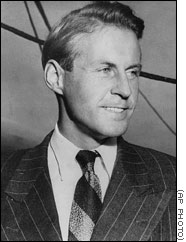
This photo was taken in 1947, the year in which Heyerdahl sailed the Pacific aboard Kon-Tiki.
The crew braved raging storms and ocean calms, with a shortwave radio their only contact with the outside world.
They often breakfasted on flying fish that landed on deck. Whales played games with the raft, and circling sharks
were constant companions. The voyage ended when wind and currents forced them aground on uninhabited Raroia atoll
in the Tuamoto Archipelago.
Heyerdahl's book, published in 67 languages, has become a classic. A black-and-white documentary film of the journey
won an Oscar in 1951.
Kon-Tiki, named after a pre-Inca sun god, became a household word. Heyerdahl was dubbed "Senor Kon-Tiki"
and "The Kon-Tiki Man" in two biographies. He is a national hero in his native Norway, and his raft sits
in Oslo's Kon-Tiki Museum.
Until very near his death, Heyerdahl continued to pursue and defend his theories. It has taken some 50 years for
the scientific establishment to appreciate his early work and grasp the full significance of the idea behind the
Kon-Tiki voyage. Admiration now comes even from some who say his theories are not proven.
"Very few people have the courage or energy to cross the boundaries between disciplines. I think Heyerdahl
is one of these people, and should be admired for it," said Erika Hagelberg, a geneticist at the University
of Oslo who has studied the DNA of American Indians and Polynesians.
Late-life interview

Heyerdahl was pictured here with his dog Reina on the Canary Island of Tenerife in February. He first arrived on
the island to excavate step pyramids there.
On February 25, weeks before he fell seriously ill, Heyerdahl sat down for an interview at a picnic table beside
an ancient South American tree on his secluded estate in the Canary Islands, Spanish territory off Africa.
Slim, with white hair, he looked fit and alert as he expounded his much-debated view that the earliest known civilizations
in Mesopotamia, Egypt, China and the Mediterranean sailed in reed ships, as depicted in their ancient art.
"That's how civilization grew. By sea, you got contact, new raw materials and inspiration," he said.
"I believe that these first navigating people were sun worshippers and that their form of temple was a step
pyramid, sometimes built over the tombs of some important royalty and always astronomically oriented with ceremonial
stairways or ramps to the summit where ceremonies were performed to the rising sun," he said.
He added that "these navigators ... also made links, with Mexico and Peru possible, and from Peru again all
the way (across the Pacific) to Western Samoa."
He scoffed at the idea that Leif Ericsson or Christopher Columbus could have been the first to sail to America.
"We Europeans are so one-track-minded when it comes to our own history that we say to the world that Europe
discovered the whole world," he says. "I say that no European has discovered anything but Europe."
'American Indians in the Pacific'
The academic world reacted to the Kon-Tiki trip by accusing him of ignoring established knowledge that Polynesia
was first settled by Asians.
"You will find that (accusation) repeated 10,000 times," he said. "That is a sheer lie and I can
prove it."
Heyerdahl said his critics read his book "Kon-Tiki" -- part science, part adventure story -- but ignored
his academic manuscript, "American Indians in the Pacific: The Theory Behind the Kon-Tiki Expedition,"
which he couldn't get published until 1952. The 800-page book uses genetic evidence such as blood types and cultivated
plants to posit that settlers from Peru arrived in Polynesia before the Asian-descended people.
The Kon-Tiki voyage upset scientists by undermining their pet theories, Heyerdahl said. "When I sailed Kon-Tiki,
that started the bombardment. I shouldn't have proven my theory correct."
'Following' step pyramids
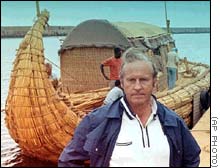
Heyerdahl was pictured with his reed vessel, the Ra II, in the Port of Safi, Morocco before leaving on a second
attempt at an Atlantic crossing.
Heyerdahl remained involved in the study of step pyramids, which -- along with reed boats and prevailing winds
and currents -- support his theories about the spread of civilization by ancient seafarers.
In the 1980s, he directed excavation of South America's largest pyramid complex, Tucume in Peru, where researchers
found reliefs of bird-headed men navigating reed ships, evidence that men sailed along the Pacific coast before
the Spanish conquest.
He first came to Tenerife to excavate six pyramids thought to be only piles of rocks built by early Spanish farmers.
But Heyerdahl recognized them as step pyramids, and now 120,000 visitors a year come to see the Chacona Pyramid
Ethnological Park.
Heyerdahl recently was excavating a structure in West Samoa that he believes could be "the western extremity"
of step pyramids built by sun worshippers.
Step pyramids are found mainly in Egypt, Mesopotamia, Mexico and Peru. Heyerdahl says there is evidence they existed
around the Mediterranean -- including some along the North Africa coast that were destroyed and rebuilt into Greek
temples. The largest is Peru's Akapana near Lake Titicaca, where the Aymara still weave reed boats.
"I don't know if it's me following the step pyramids or it's the step pyramids following me. There has been
a chain of them my whole life," Heyerdahl said.
"Usually you consider yourself fortunate to find some potsherds when you look for archaeology, but it is rather
unusual to stumble over step pyramids, and still, this has happened to me in three world oceans."
Copyright 2002 The Associated Press. All rights reserved.
Adventurer Thor Heyerdahl dead at 87
Sailed the Kon-Tiki from Peru to Polynesia
April 18, 2002 Posted: 4:40 PM EDT (2040 GMT)
OSLO, Norway (AP) -- Thor Heyerdahl, the Norwegian explorer who crossed the Pacific on a balsa-log raft and detailed
his harrowing 101-day voyage in the book "Kon-Tiki," died Thursday night. He was 87.
Heyerdahl stopped taking food, water or medication in early April after being diagnosed with a terminal brain tumor.
Relatives said he died in his sleep at a hospital near his family retreat at Colla Michari, Italy.
Experts scoffed at Heyerdahl when he set off to cross the Pacific aboard a balsa raft in 1947, saying it would
get water logged and sink within days.
After 101 days and 4,900 miles, he proved them wrong by reaching Polynesia from Peru, in a bid to prove his theories
of human migration.
His later expeditions included voyages aboard reed rafts, Ra, Ra II and Tigris. His wide-ranging archaeological
studies were often controversial and challenged accepted views.
Heyerdahl maintained a high pace of research, lectures and travel until his sudden illness. He moved to Tenerife
in 1990 but kept Colla Michari as a retreat.
Debate and contention
Throughout his life, Heyerdahl continued to challenge accepted scientific beliefs, with expeditions aboard the
reed boats Ra, Ra II and Tigris, as well as archaeological studies around the world.
Despite his advanced years, he remained an active researcher and lecturer until his illness. His wife Jacqueline
said he boarded 70 airline flights in 2001.
Heyerdahl was born Oct. 6, 1914, in the southern Norway town of Larvik. He was the son of a widely traveled banker
and a mother with a scientific bent, who he remembered gave him anthropology books instead of children's books
to read when he was sick in bed.
The school in his hometown was renamed the Thor Heyerdahl Secondary School in 1995.
Heyerdahl was rushed to Santa Conora hospital on the Italian Riviera nearly three weeks ago after becoming ill
during a family gathering at Colla Michari.
At his request, he was released from the hospital and brought back to Colla Michari to spend his final days surrounded
by family.
"He wanted to go there -- to use his words -- because it was time to hang up his oars and ride into the sunset,"
his oldest son said earlier.
Thor Heyerdahl Jr. said his father had expressed happiness and satisfaction with his life before slipping into
unconsciousness on Tuesday.
Home and history
Heyerdahl was a frequent visitor to Norway, where the Kon-Tiki museum in Oslo maintained an apartment for his use.
He became a national hero in this maritime nation of 4.5 million people that voted him Norwegian of the Century
in a 1999 newspaper poll.
His later studies focused on ancient step pyramids -- including those in Peru and on the island of Tenerife off
Africa -- which he believed could show maritime links between ancient civilizations.
He had nearly drowned twice as a child in Larvik, Norway, and overcame his fear only at age 22, when he fell into
a raging river in Tahiti and swam to safety.
"If you had asked me as a 17-year-old whether I would go to sea on a raft, I would have absolutely denied
the possibility. At that time, I suffered from fear of the water," Heyerdahl once said.
Funeral plans were not immediately announced.
Copyright 2002 The Associated Press. All rights reserved.
New crowd takes up Kon-Tiki theories
'Thor Heyerdahl led the way years ago'
April 18, 2002
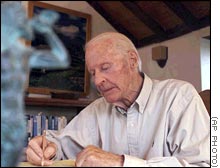
GUIMAR, Canary Islands
(AP) -- While Thor Heyerdahl's theories on ancient seafarers spreading civilization were initially ridiculed by
scientists, a younger generation is studying his ideas from five decades ago as the basis for new ideas about early
cultural exchanges.
Robson Bonnichsen, who studies how the American continent became populated, calls Heyerdahl "a visionary ahead
of his time."
Bonnichsen, director of the Center for the Study of the First Americans at Oregon State University, told The Associated
Press that many experts now give serious consideration to the idea that people in boats sailed along the Pacific
Rim.
"Our perception of the peopling of the Americas is changing" and encompasses more than one colonization,
including an early population from Southeast Asia, he said.
"A lot of new ideas are on the table -- and Thor Heyerdahl led the way years ago," he said.
The new theories suggest that American settlement was much more complex than first thought and that migrants arrived
more than once and from different parts of the world.
Dennis Stanford, an anthropologist at the Smithsonian Institution's National Museum of Natural History in Washington,
has even suggested some American ancestors could have come from Spain during the Ice Age, arriving in Maine after
skirting the ice of the North Atlantic in boats.
Walter Neves of the University of Sao Paulo is gathering evidence suggesting that early South Americans originated
in Australia or South Asia and possibly crossed the Pacific.
'Kon-Tiki DNA' inconclusive
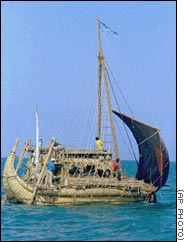
Erika Hagelberg, a geneticist at the University of Oslo, says the study of DNA in the Pacific has not proven Heyerdahl's
theories right or wrong. "There is definitely a genetic connection between Polynesians and Native Americans,
but it probably traces back to a common origin in Asia," she said.
Hagelberg, who has received some Kon-Tiki Museum grant support, says there is no genetic data that indicates a
strong South America influence in Polynesia, but "that does not rule out a connection, as there are many reasons
why South American genes might not be detected in Polynesia today."
She noted that it will probably take scholars from various sciences to thoroughly examine Heyerdahl's work and
lauded him for the way he crossed the boundaries between scientific disciplines.
Further praise for Heyerdahl is evinced by the 11 honorary doctorates he has received from universities in the
Americas and
Europe.
In his 1997 memoir, "In the Footsteps of Adam," he frequently makes the point that academic specialists
often fail to see the forest for the trees.
"The more I do and the more I see, the more I realize the shocking extent of ignorance that exists among the
scholarly circles that call themselves authorities and pretend to have a monopoly of all knowledge," he wrote.
Copyright 2002 The Associated Press. All rights reserved.